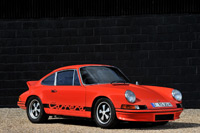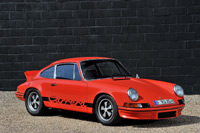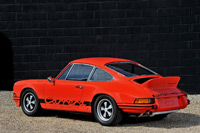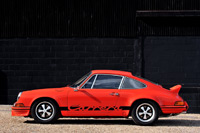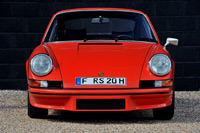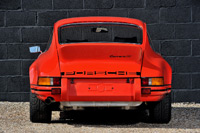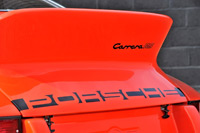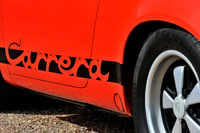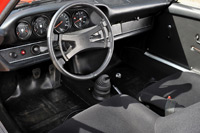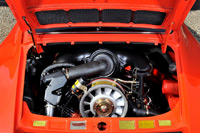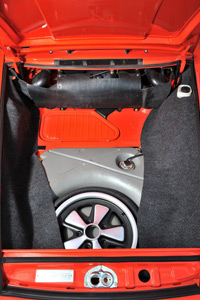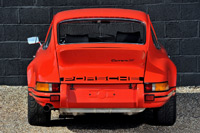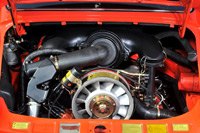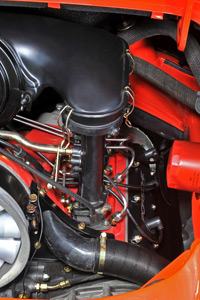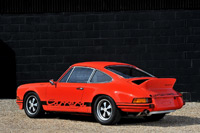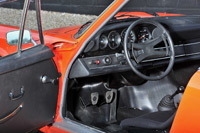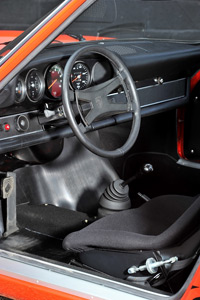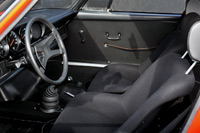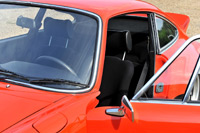Porsche Carrera RSL #1014 9113601014
The ultimate 911. There is no more iconic silhouette than that of the early 911 and of all the variations and differences in these cars the shape of the 2.7 RS with its Aerodynamic ducktail is the most instantly recognisable. It captured the imagination like the Jaguar E type had a decade before, and the initial run of 500 sold out almost immediately. Porsche had to reinstate production to build more – another 1,090, in fact – in order to meet demand. RS stands for Rennsport in German, meaning "racing sport". The Carrera name was reintroduced from the 356 Carrera which had itself been named after Porsche's victories in the Carrera Panamericana races in Mexico in the 1950s. The reference ''RS'' will quicken the pulse of Porsche connoisseurs. Models such as the legendary Carrera RS 2.7 of 1972, the 1991 964 911 RS, the 2004 996 GT3 RS and the 2007 997 GT3 RS are all normally aspirated sports cars that stand out on account of their extreme degree of manoeuvrability and handling.
These sensational cars also achieved great success on the race track, RS both in touring and in lightweight spec were raced in almost every sports car race, and the lightly modified RSR examples scored victories in the Targa Florio, the 24 Hours of Daytona and the 12 Hours of Sebring all in their first year. Weighing in at only 975kg, 2.7 RS's have an impressive top speed of 150mph and performance figures of 0-65mph in just 5.8 seconds. Porsche built just 200 2.7 RSs in lightweight trim, which differed from Touring specification cars in the following ways; The fibreglass front and rear bumper panels had no metal and rubber trim added (just black tape), likewise there was no trim along the sides of the sills and no over-riders. The cars were fitted with lightweight racing seats fitted with turnbuckle adjusters and there was no clock fitted. There were no rear seats and no carpets in the front footwell, just rubber mats. The rear side windows were fixed whilst the doors have basic "railway carriage" pull leather strap openers and small plastic black draw handles with no door pockets. Under the bonnet there was only one battery (two in the Tourings), no "T" pull in the l/h door shut to open the engine compartment but two rubber "T" handles connected to a metal double hook fixed to the base of the bootlid. Supplied in this basic trim the lightweight cars were usually dispatched to privateer gentleman racers for competition use.
RS #1014 (Chassis: 9113601014) is one of the finest examples extant, supplied new to Padova in stunning Tangerine with Conversion 471 this is one of just 200 Fabled RS Lightweights. Tangerine or “Blutorange” (BloodOrange) has become iconic and synonymous with the mighty Carrera RS and its astonishing racing record. The colour is now widely acknowledged as the colour for any Carrera RS. This car is the 12th of just 16 2.7 RS Lightweights originally painted this sensational colour as the car is presented today. Supplied new by BaldrinAuto who raced as many as 2.7 RS examples in this period this car has a long history of competition throughout the 1970s and into the 1980s. Although initially raced in the car’s original Tangerine by 1976 the success of the car had attracted a number of high profile sponsors including Radio Padova and alloy wheel manufacturer “Eta Beta”, Glasses maker “Nylor” and Zambelli, with these sponsors on board the car’s livery was changed to White and Green. The car continued to race successfully and won the Northern Italian Rally Championship in 1976 and in 1977 the car won the Group3 Rally Alto Appennino Bolognese (“RAAB”) a very famous and tough rally in which the car competed in on four different occasions! The car also contested the first three editions of the Rally 1000Miglia!! These wonderful results attracted further sponsorship and the livery again changed this time the car would bear the most iconic motorsport Livery in history the as the car was painted in the famous Gulf Livery on of a small number of cars to compete in this livery the car contested the famous Targa Florio, the Rally 1000Miglia, Rally San Marino and Rally Modena to name but a few. Throughout the 70s and early 80s, this RS #1014 became an Italian rally Icon.
Following retirement from international racing the car was returned to road use with the then current style road bumpers being fitted to the car, the car remained in Padova until in 1986 when two German Porsche enthusiasts aware of the significance of such an important car purchased it from the then owner and drove the car back to Germany where upon with the help of a renowned German Porsche restorer and expert the car was restored back to Carrera RS lightweight spec.
After the completion the car was driven and showcased at Hockenheim. This gentleman, a serial Porsche collector, would keep the car for many more years driving in a number of non-competitive tours and rallies including the German 911 30th Anniversary in 1993 in Stuttgart. The car was featured in a popular German newspaper with the then owner. In 2008 the car was sold to a Frankfurt based businessman, the new owner of the car entrusted the car with the same restorer who had converted the car back to RS specification 20 years prior and together they embarked up on a bare shell restoration of #1014. In 2014 upon meeting again with the original German owner he confessed that of all the Porsche he had owned, his greatest regret was selling the best of all of these RS #1014. The restoration of #1014 took over 12 months to complete, the car was stripped all the way to back to a bare shell. As the car was being stripped the original Tangerine paint was abundantly clear beneath the white paint and beneath the trim items, the rest of the corroborated to the finest detail the stories and photographs from the cars racing history, the floor showed rally damage from the number of stones thrown up in the loose gravel stages, damage on the car even matched known damage from various rallies. It was totally clear that this car was the famous RS from Italy!
This restoration was completed and the car resided in the owner’s private collection in Frankfurt. In 2013 the car was purchased by DK Engineering and today remains in the care of DK on behalf its private owner.
Photo Gallery
Porsche RSL #1014 Ownership History
- 04/1973 - Completed by Porsche to Carrera RS Lightweight Specifications, the 12th of just 16 Tangerine Examples.
- 06/1973 – Supplied by Padova Based BladrinAuto, Registered in Italy to the small town of Valenza.
- 06/1976 - Sold to 2nd Italian Owner Based in Padova.
- 03/1978 – Sold to 3rd Owner, Based in Castenedolo a small Commune close to Brescia.
- 02/1979 – Sold to 4th Owner who lived 100kms north of Venice.
- 09/1981 – Sold to 5th Owner from Piazzola Sul Brenta, close to Padova.
- 01/1986 – Sold to German Porsche Enthusiast and Driven from Padova to Germany.
- 05/2008 – Sold to 2nd German Owner and then Restored.
- 06/2013 - Sold to Current British Owner, UK registered and stored with DK Engineering.
